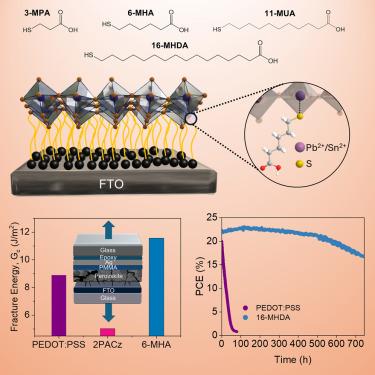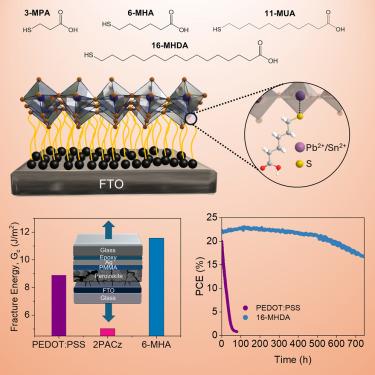A chemically bonded monolayer interface enables enhanced thermal stability and efficiency in Pb-Sn perovskite solar cells
IF 35.4
1区 材料科学
Q1 CHEMISTRY, PHYSICAL
引用次数: 0
Abstract
Advances in narrow-band-gap (NBG) mixed lead-tin (Pb-Sn) perovskites have enabled increasingly efficient all-perovskite tandem solar cells, yet device stability remains limited by acidic poly(3,4-ethylenedioxythiophene) polystyrenesulfonate (PEDOT:PSS) hole transport materials (HTMs). Although carbazole-based self-assembled monolayers (SAMs) were considered as alternatives, they also degrade rapidly (T80 < 200 h) under external stresses. We identified weak chemical interaction at the transparent conductive oxide:SAM:perovskite interface and hypothesized that stronger binding could enhance stability. Introducing bifunctional SAMs with thiol groups established robust S-Pb chemical coordination, improving fracture energy by 30%. Replacing acidic phosphonic groups with milder carboxylic groups and optimizing SAM chain length led to selecting 16-mercaptohexadecanoic acid (16-MHDA), balancing coverage, energy alignment, and series resistance. This approach doubled photocarrier lifetime and increased thermal degradation resistance by 1.3×. Single-junction Pb-Sn cells achieved 24% power conversion efficiency (PCE) and encapsulated devices retained 80% efficiency after 680 h under 1-sun illumination at a heatsink temperature of 50°C.


化学键合单层界面增强了铅锡钙钛矿太阳能电池的热稳定性和效率
窄带隙(NBG)混合铅锡(Pb-Sn)钙钛矿的进展使得全钙钛矿串联太阳能电池的效率越来越高,但器件的稳定性仍然受到酸性聚(3,4-乙烯二氧噻吩)聚苯乙烯磺酸盐(PEDOT:PSS)空穴传输材料(HTMs)的限制。尽管基于咔唑的自组装单层膜(sam)被认为是一种替代品,但它们也会迅速降解(T80 <;200h)外应力作用下。我们在透明导电氧化物:SAM:钙钛矿界面上发现了弱的化学相互作用,并假设更强的结合可以提高稳定性。引入巯基双功能SAMs建立了稳健的S-Pb化学配位,将裂缝能提高30%。用较温和的羧基取代酸性膦基,并优化SAM链长,从而选择16-巯基十六酸(16-MHDA),平衡覆盖、能量排列和串联抗性。这种方法使光载流子寿命增加了一倍,并使热降解阻力提高了1.3倍。单结铅锡电池的功率转换效率(PCE)达到24%,封装器件在50°C的散热器温度下,在1个太阳照射680小时后仍保持80%的效率。
本文章由计算机程序翻译,如有差异,请以英文原文为准。
求助全文
约1分钟内获得全文
求助全文
来源期刊

Joule
Energy-General Energy
CiteScore
53.10
自引率
2.00%
发文量
198
期刊介绍:
Joule is a sister journal to Cell that focuses on research, analysis, and ideas related to sustainable energy. It aims to address the global challenge of the need for more sustainable energy solutions. Joule is a forward-looking journal that bridges disciplines and scales of energy research. It connects researchers and analysts working on scientific, technical, economic, policy, and social challenges related to sustainable energy. The journal covers a wide range of energy research, from fundamental laboratory studies on energy conversion and storage to global-level analysis. Joule aims to highlight and amplify the implications, challenges, and opportunities of novel energy research for different groups in the field.
 求助内容:
求助内容: 应助结果提醒方式:
应助结果提醒方式:


